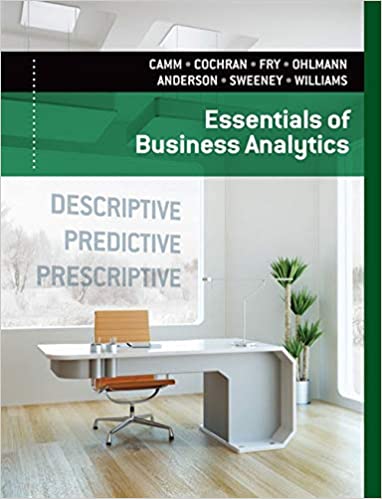
Essentials of Business Analytics 1st Edition by Jeffrey Camm,James Cochran,Michael Fry,Jeffrey Ohlmann ,David Anderson
Edition 1ISBN: 978-1285187273
Essentials of Business Analytics 1st Edition by Jeffrey Camm,James Cochran,Michael Fry,Jeffrey Ohlmann ,David Anderson
Edition 1ISBN: 978-1285187273 Exercise 8
Consider the following time series data:

a. Construct a time series plot. What type of pattern exists in the data
b. Use a multiple regression model with dummy variables as follows to develop an equation to account for seasonal effects in the data. Qtr1 5 1 if quarter 1, 0 otherwise; Qtr2 5 1 if quarter 2, 0 otherwise; Qtr3 5 1 if quarter 3, 0 otherwise.
c. Compute the quarterly forecasts for next year based on the model you developed in part b.
d. Use a multiple regression model to develop an equation to account for trend and seasonal effects in the data. Use the dummy variables you developed in part b to capture seasonal effects and create a variable t such that t 5 1 for quarter 1 in year 1, t 5 2 for quarter 2 in year 1, … t 5 12 for quarter 4 in year 3.
e. Compute the quarterly forecasts for next year based on the model you developed in part d.
f. Is the model you developed in part b or the model you developed in part d more effective Justify your answer.

a. Construct a time series plot. What type of pattern exists in the data
b. Use a multiple regression model with dummy variables as follows to develop an equation to account for seasonal effects in the data. Qtr1 5 1 if quarter 1, 0 otherwise; Qtr2 5 1 if quarter 2, 0 otherwise; Qtr3 5 1 if quarter 3, 0 otherwise.
c. Compute the quarterly forecasts for next year based on the model you developed in part b.
d. Use a multiple regression model to develop an equation to account for trend and seasonal effects in the data. Use the dummy variables you developed in part b to capture seasonal effects and create a variable t such that t 5 1 for quarter 1 in year 1, t 5 2 for quarter 2 in year 1, … t 5 12 for quarter 4 in year 3.
e. Compute the quarterly forecasts for next year based on the model you developed in part d.
f. Is the model you developed in part b or the model you developed in part d more effective Justify your answer.
Explanation
Consider the provided details and the da...
Essentials of Business Analytics 1st Edition by Jeffrey Camm,James Cochran,Michael Fry,Jeffrey Ohlmann ,David Anderson
Why don’t you like this exercise?
Other Minimum 8 character and maximum 255 character
Character 255


